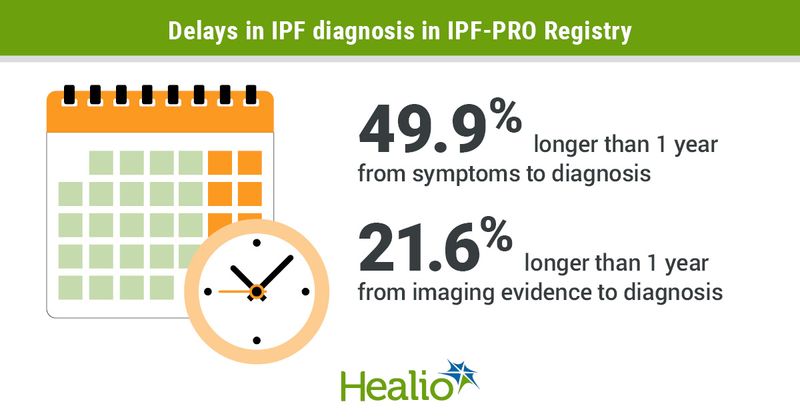Delay from symptom onset to IPF diagnosis often longer than 1 year
In the IPF-PRO Registry, 50% of patients had a delay of longer than 1 year between symptom onset and diagnosis of idiopathic pulmonary fibrosis.
Laurie D. Snyder, MD, MHS, associate professor of medicine at Duke University School of Medicine and member of the Duke Clinical Research Institute, and colleagues analyzed data from 498 patients in the IPF-PRO Registry enrolled from June 2014 to March 2019. Patients received a first diagnosis of IPF at one of 40 IPF-PRO Registry enrolling centers in the U.S. and had medical documentation on symptom onset and/or high-resolution CT scans showing pulmonary fibrosis.

Median time from IPF symptom onset to diagnosis was 13.6 months. In 50% of patients, the median time from symptom onset to diagnosis was more than 1 year, according to an e-poster from the American Thoracic Society Virtual meeting.
Median time from imaging evidence of pulmonary fibrosis to diagnosis was 3.5 months. In 21.6% of patients, time from imaging evidence to diagnosis exceeded 1 year.
Cardiac comorbidities were more frequent in patients with a longer time from symptom onset or imaging evidence of IPF to diagnosis. This included coronary artery disease, atrial fibrillation or flutter, pulmonary hypertension and prior deep vein thrombosis or pulmonary embolism.
Researchers observed no significant difference in univariable and adjusted models for time to death or lung transplant between patients with longer vs. shorter time from symptom onset to IPF diagnosis (P = .41 and P = .25, respectively) and time from imaging evidence of pulmonary fibrosis to IPF diagnosis (P = .55 and P = .24, respectively).
“Despite improved awareness of IPF, there remains a long period from symptom onset to diagnosis in a large proportion of patients,” Snyder and colleagues wrote in the e-poster. “Getting [a high-resolution CT] scan performed is a critical step in the diagnostic process.”
Reference:
Snyder LD, et al. Am J Respir Crit Care Med. 2020;201:A2565.

